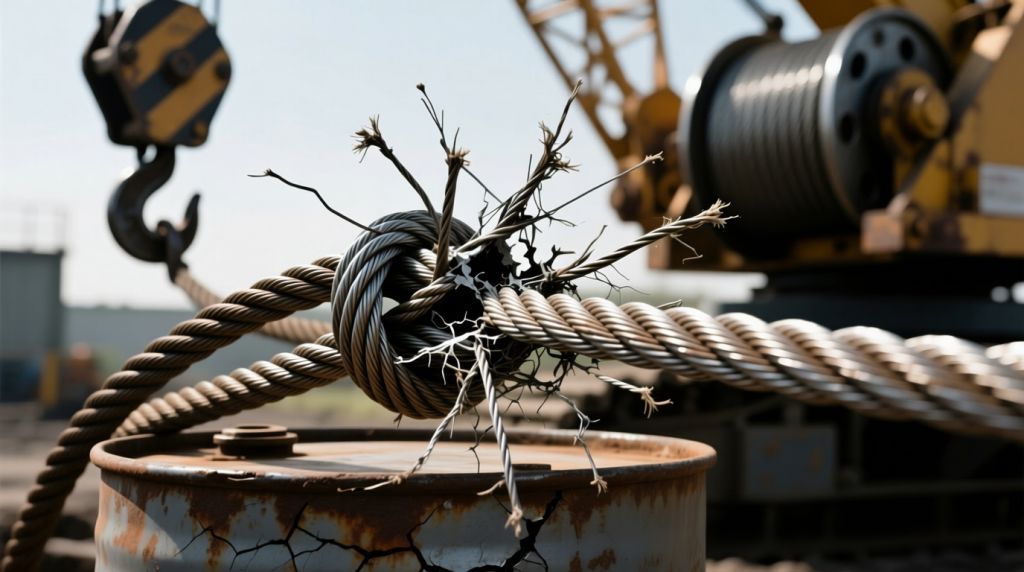The wire rope on a Grove crane is the critical link between the machine and the load it lifts. When it fails, the risks are immense—dropped loads, equipment damage, or serious injuries. This article is for operators, riggers, maintenance crews, and fleet managers who maintain Grove cranes. If you spot any of these five signs, act fast to replace the rope and keep operations safe.
1. Broken Wires and Fraying
A single broken wire is a concern, but clusters of broken strands are a critical issue. Inspect the entire rope length, especially areas that bend over sheaves or pass through the hook block, as these endure significant stress. Fraying appears as loose, unraveling strands, while bird-caging shows strands bulging into loops.
These signs indicate the rope’s structural integrity is compromised. Temporary fixes like taping frayed areas are unsafe and ineffective. Replace the rope immediately, sourcing it from a supplier of Grove crane parts to ensure it meets your crane’s specifications for strength and construction.
2. Rust and Surface Pitting
Corrosion is a hidden danger that weakens wire ropes internally. Pitting, visible as small craters on the wires, creates weak points prone to breaking under load. Cranes in coastal areas, humid climates, or near chemical plants are particularly susceptible to rust.
Look for brown staining, flaking metal, or widespread rust, especially in areas where water collects. If corrosion or pitting is evident, the rope’s capacity is reduced. Replace it promptly and improve lubrication and storage practices to protect the new rope. Grove crane parts from a trusted supplier ensure compatibility and long-term performance.
3. Kinks, Flat Spots, or Bird-Caging
A wire rope should remain round and flexible. Flat spots form when the rope is improperly spooled or crushed under heavy loads. Kinks occur when a loop is twisted and tightened, and bird-caging happens when strands separate and bulge outward.
These deformations cause uneven stress, leading to accelerated wear and potential sudden failure. If you notice kinks, flat spots, or bird-caging, stop crane operations immediately. Attempting to fix these issues under load is dangerous. Replace the rope and investigate causes like spooling errors or damaged drum grooves to prevent future issues.
4. Damage at End Fittings
End terminations—where the rope connects to sockets, wedges, or clips—face intense wear. Look for crushed wires, severe abrasion, or corrosion under fittings. Loose or incorrectly installed clips can cause slippage, further damaging the rope.
Inspect thimbles and sockets for wear or sharp edges that could cut into the rope. If the termination area shows damage, replace both the rope and the fittings. Using certified Grove crane parts from a reliable supplier like HL Equipment ensures proper fit and load capacity, preventing repeat failures.
5. Stretching or Diameter Loss
Normal stretching occurs over time, but rapid or uneven stretching signals trouble. Measure the rope’s diameter regularly; a reduction beyond tolerances indicates internal wire breaks or core collapse. Backspinning, where the rope twists or unwinds unexpectedly, suggests core slippage or improper spooling.
Both conditions weaken the rope and increase the risk of failure. If you observe stretching, diameter loss, or backspinning, remove the crane from service and replace the rope immediately. Grove crane parts ensure the replacement meets your crane’s operational requirements.
Actions When Issues Are Found
If any of these signs appear, halt crane operations immediately. Follow safety protocols, tag out the crane, and safely lower any load in use. Document the rope’s condition with photos and record its service history, including hours, loads, and environmental factors.
Source replacement ropes and fittings from a trusted supplier of Grove crane parts. Generic ropes may not meet the required strength or construction standards, risking failure. Suppliers like HL Equipment can confirm the correct rope specifications for your Grove crane, ensuring safety and reliability.
Inspection and Maintenance Guidelines
Inspection frequency depends on usage. Light-duty cranes need less frequent checks than those handling heavy loads daily. Operators should perform daily visual inspections, while qualified technicians should conduct detailed checks weekly or per regulatory guidelines. Log rope age, usage, and incidents to inform replacement decisions.
Preventive Measures for Rope Longevity
Lubricate ropes with a penetrating wire rope lubricant to reduce friction and corrosion. Store ropes in a dry, covered area off the ground. Inspect and replace worn sheaves, drums, or hooks promptly, using Grove crane parts for compatibility. Ensure fittings are installed by trained technicians. Train operators to spot early signs of damage to prevent escalation.
Why Replacement Can’t Wait
A failing wire rope risks catastrophic accidents—dropped loads, crane damage, or crew injuries. The cost of timely replacement is negligible compared to the consequences of failure, including downtime, repairs, and legal issues. Proactive replacement based on inspections is the safest approach.
Final Thoughts
Wire rope is a critical component that requires constant monitoring. Watch for fraying, corrosion, deformations, termination damage, or abnormal stretching. Replace the rope at the first sign of trouble, using high-quality Grove crane parts from a trusted supplier. Regular inspections, proper maintenance, and prompt replacements ensure your Grove crane remains safe and operational.


